Tired of getting out of the car into the bone-chilling night air to open the garage door? Imagine how much easier it would be to be greeted by a garage door that opens at the touch of a button. Install a garage door opener and enjoy the comfort and safety of automatic access to a safe, well-lit garage.
Garage door openers can be installed on a complete range of roller doors or sectional style doors.
Installing a garage door opener is a project that most DIY home handymen should be able to accomplish successfully.

When deciding on a garage door opener, there are several factors to take into consideration:
- A screw-drive system uses a lifting mechanism that moves along a threaded steel rod. These units are powerful and, because they have few moving parts, they require the least maintenance. The body of the opener rests in the center of the garage ceiling.
- A chain-drive system uses a metal chain to lift the door up and down along its tracks. Chain-drive systems are the most common and usually the least expensive, but they sometimes make more noise than screw-drive units. Like screw drives, chain drives sit in the center of the garage ceiling.
- At least one manufacturer now offers a computer-controlled drive mechanism that uses no chain or screw. The body of the unit sits directly above the door, rather than in the middle of the ceiling. This is particularly helpful in garages that have limited headroom, and it leaves more garage ceiling space open for storage.
Power:
Choose a motor with power adequate to lift your door. If you have a double door, look for at least 1/2 hp. Even on a single door, a larger motor is likely to last longer.
Look for a unit with soft
starting and stopping, which operates more quietly and with less wear and tear on the door.
Speed:
Higher-end openers operate more quickly, reducing the time you have to wait in the driveway. For safety's sake, the faster-opening models still close at a standard, slower speed.
Safety:
Mandated by federal law, all garage door openers include features that stop the doors from crushing objects in their paths and cause the doors to reverse direction if they strike something. In most cases, this is controlled by an electronic beam that, when broken by a person or object, triggers the safety mechanism.
The computer-controlled system measures the normal operating speed and time of the door and can sense and compensate for changing conditions — such as a door closing too quickly or making contact with an obstruction.
Security:
All garage door openers produced today use rolling codes
for the greatest security. Each time the door is opened (using the remote transmitter), a new, random code is generated. This prevents code theft and ensures that a neighbor's remote control will not open your garage.
All models also include a manual release that will allow you to open the door if the power is out. Some higher-end models include a function that opens the door just a little bit so the cat or dog can get out.
Remote Control:
Some models use a one-button remote control transmitter, and others include a remote (transmitter, clicker..) with two or more buttons that can control multiple garage openers. Multiple buttons are useful if you have more than one garage bay, each with a separate door.
Some brands offer mini-remotes that are small enough to fit on a keychain.
One, two and three button remotes, keychain remotes, and a fixed keypad remote all allow secure access into your garage.
Fixed Control:
Doorbell-like buttons or keypads can be mounted to the wall — interior or exterior — near the door to allow it to be opened without a remote. Look for this as an accessory if it does not come as part of the standard opener kit.
Some keypads allow you to lock the door electronically for a specific amount of time, such as when you are going to be away on vacation. Another popular function is delayed closing — a pause between the time the button is pushed and the door is closed. You have plenty of time to exit through the door on foot without having to run through, dodging the lowering door and the electronic beams.
Lighting:
Most openers include a security light that comes on as you activate the system and stays on long enough for you to get out of the car and go into the house. Many remotes include buttons that turn on the light without activating the door.
